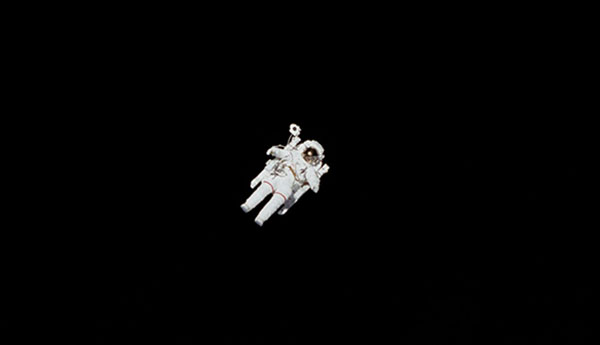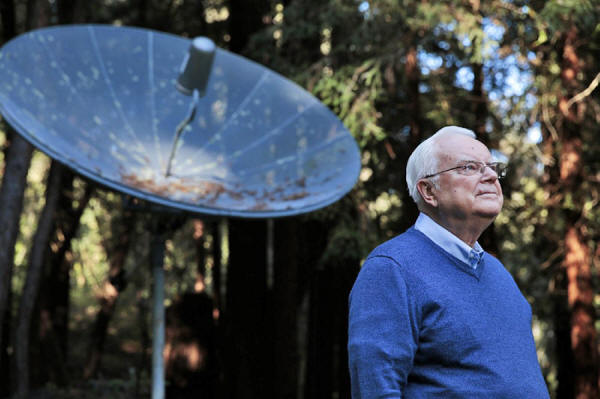|
from Medium Website
The search for intelligent life reaches farther than any NASA mission...
We slip from questions of molecules arranging themselves into life to questions of humanity and meaning - what is life, what is intelligence - and philosophy.
NASA sends probes to comets and planets and moons to look for organic molecules, the chemical signatures of life or at least its possibility, but there is also the big gun, the moon shot:
It's a different process, different science, but the hope of its quarry also carries vastly different meaning.
I don't think alien
microbes, astonishing as they'd be, would make us any less alone in
the cosmos. SETI isn't a search for company, though. It's a search
for signals.
Then she's screaming.
But the signal is louder than her yelps: It's a rhythmic whoosh with an electronic whine. Because this is a movie, she knows right away that it must be an alien signal from outer space.
Arroway speeds back to her laboratory office, shouting the signal's coordinates to her colleagues through a walkie-talkie so they all know where to point their telescopes.
They connect speakers to their computers, and when the sound kicks in, their frantic racing pauses for a moment in wonder:
It's a galvanizing moment, but it's also not at all how this kind of signal detection would happen in real life.
Raw signals require
computers to process them, to draw significance from the murk of
numbers and noise. And the scene also perpetuates, at least
indirectly, a massive misconception: that astronomers who use radio
telescopes to "listen" for alien signals are searching for sound.
Photo by Universal Images Group via Getty Images
When you hear the word "radio," you think of sound.
So when we read about "radio telescopes," we think about listening to space. Scientists talk about "listening" for signs of extraterrestrial life, like Foster's Arroway was literally doing on those headphones when she heard the extraterrestrial whoosh...
But radio telescopes are not sound receivers; the famous 305-meter Arecibo dish is not a very large hand cupped around a sensitive ear.
The radio waves these telescopes collect are the same signals that give us our AM and FM channels and transmit cellular and Wi-Fi signals. And they're not sound waves at all - they're just very long, very slowly undulating waves of light.
Astronomers can "see" space in light wavelengths far beyond the visual spectrum. (Many of the beautiful space photographs you've seen are not just color-enhanced for contrast, but show more than visual light, tinted and composited to carry more information to our eyes.)
By observing radio waves, astronomers can observe galaxies, star formation, fading supernova remnants, and distant clouds of gas. Radio waves are so long - their wavelengths are about a billion times longer than those of visual light - that they don't interact with the molecules of the atmosphere.
They slip right through.
This is why we use them to transmit information, because they can pass through air with no interference. And this means radio observations can happen on Earth, with no need to fling a telescope into orbit.
That also makes them good candidates for alien signals. If an alien civilization uses radio signals like we do, we could catch those signals. Just as our atmosphere is transparent to radio waves to detect them, it is transparent to their leakage outward.
Whether by design or accident, an alien civilization that uses radio waves to communicate could also communicate its presence to us.
Dr. Frank Drake, the founder of SETI. Photo by Ramin Rahimian for The Washington Post via Getty Images
Frank Drake was just starting his astronomy career when he had the idea to look for these alien signals.
In 1958, he was hired to work at a new observatory in West Virginia and wondered,
Luckily, the man running the observatory shared Drake's curiosity about (or belief in) extraterrestrial life and gave the go-ahead to his strange endeavor.
That was Project Ozma, named for the queen of L. Frank Baum's Oz.
It lasted four months, with six hours of listening per day targeting two specific stars - Tau Ceti and Epsilon Eridani - each about 11 light-years away. That was the farthest from which Drake calculated he could detect a signal.
By now, you might know he didn't find one. (Or you realize that you probably would have known if he had.)
But it was just the precursor to what would become Drake's legacy, and one of the most powerful forces in the cultural and scientific conversations about alien life:
SETI was first a category of work (like Drake's) and later became the name of the institute that would carry it on.
It is also the work Contact is based on - well, the movie's based on Carl Sagan's novel of the same name - and Foster's Arroway is based on Jill Tarter, the SETI institute's longtime director.
Between 1960's Project Ozma and 1993, SETI work was mostly funded by NASA, with patchworked, sporadic spans of observing time on the world's largest radio telescopes, scanning the sky or listening more closely to smaller patches. (Given the same telescope strength and time, the smaller your field, the weaker a signal you can detect.)
In 1993, Congress cut NASA's funding for SETI.
Senator Richard Bryan said,
NASA has gone on to hunt for Martians and Europans and Enceladusians - aliens of the microbial, and perhaps extinct, variety.
But the government hasn't funded SETI research since.
Coincidentally in 1993 came one of the strongest confirmations of SETI's potential. In 1990, NASA's Jupiter-bound Galileo probe executed a fly-by of Earth, using our planet's gravity to slingshot itself toward its destination.
The probe was equipped with a range of powerful sensors, making it a rare opportunity to observe our own planet from a good distance away. A research team led by Sagan pointed Galileo's equipment homeward to see if we could detect signs of life on an inhabited planet.
The team was mainly looking for signs of biological activity - oxygen, methane, the light signatures of photosynthesis - and in findings (A Search for Life on Earth from the Galileo Spacecraft) published in 1993, they found that those were detectable. But a blaring-loud signal heard above everything else was not organic at all - our radio signals were seeping out into space.
They could hear us - we could hear ourselves. It was a reminder that organic life is detectable, but technological life is loud.
For the past 25 years, SETI work has been privately funded. In addition to the SETI Institute being a home for astrobiology research - delving into Mars' watery, more hospitable past and devising missions to the moons of Saturn and Jupiter to investigate their oceans - it finally has its own dedicated telescope array.
With copious funding from Microsoft co-founder Paul Allen, SETI built the Allen Telescope Array, a field of 42 telescopes with the cumulative collecting range and resolution of a single large dish, but with much more flexibility - and room for growth.
Right now, researchers are a bit more than halfway through a two-year survey of 20,000 red dwarf stars.
These are intriguing candidates for SETI because they burn much more slowly than brighter, hotter stars like our yellow sun. This gives planets around red dwarf stars - and plenty have been found - a much wider window, by billions of years, to develop life.
(SETI doesn't limit its search to stars with known planets - since planets have, in the past decade, proven to be so abundant, the odds of a star having planets is high enough that researchers figure they might as well check out every star.)
It's largely thanks to NASA-funded research that those copious exoplanets have been found.
And NASA does plenty of research looking for signs of life in our solar system and beyond - they just keep it to what astronomer Jason White calls "stupid life."
Recently, White wrote an op-ed for Scientific American arguing that NASA should fund SETI work because it's just as plausible a path as searching for biological signs of life.
However common life is in the universe, technologically advanced life - defined for SETI purposes as life that uses radio waves to transmit information - is, necessarily, less common.
I suppose there's a chance that every single planet that's given rise to a microbe is currently home to an advanced civilization, but in this game of long odds, that precise outcome seems the longest.
(There's also a chance that radio detectability isn't the pinnacle of technological advancement, but a phase, that civilizations leak signals for a century or two before progressing to more sophisticated methods of communication. In terms of why we might not be able to find proof of aliens, it's a nice alternative to them having blown themselves up.)
Intelligent life - detectable to our methods - is just a subset of life in the universe...
Yet it is also much louder than the signals of plain biology,
It would be all the more meaningful, not to mention sadder - barring an alien spaceship coming for a visit or a distant civilization possessing the ability to break the laws of physics to communicate or travel, any alien civilization we detect will be untouchably distant.
In Contact, the vastness of space is overcome by blueprints encoded in the alien signal for a massive construction that will somehow - and no one can tell how - propel a single-passenger pod.
Arroway takes on the mission herself.
But I'm glad she got to make the journey herself, traveling through wormholes and experiencing an encounter with an alien intelligence. That is, if you believe her.
Arroway returns to find that while she experienced being gone for many hours, on Earth it was as if no time had passed at all - to her colleagues, the little pod had just fallen through the launch machinery into a safety net.
Arroway insists that she was in space, but all her recording devices catch nothing but static. There's no proof of the encounter - except the static is 18 hours long.
Arroway is guided by the aliens who sent the message, led into the fellowship of spacefaring civilizations. But however unlikely a signal may be, it's the hand-holding that is infinitely more far-fetched. In real life, no one is going to tell us what to do.
Would we send a reply and wait centuries for the next step in the conversation?
Today, there are people willing to travel to Mars for what is surely a one-way trip. Tomorrow, with a just whisper eavesdropped from across the stars to go off, would people line up to be the first passengers on a centuries-long journey?
Science fiction is full of generation ships that let us traverse untraversable space, not with warp engines or tesseracts, but with patience:
If we received an alien signal, would we find the fortitude for that?
Even if we didn't make the journey, how would life on Earth change with the knowledge that someone - not just something, but someone - is out there?
Astronomers and sociologists and futurists have speculated:
(For all our X-Files fears, SETI researchers are a generous and idealistic bunch, and since SETI isn't government-funded, they'd be free to share their findings.)
I imagine there'd suddenly be plenty of funding for SETI, for expanding the search and focusing our telescopes on this newly discovered alien home.
I hope, at the very least, we'd send them a message:
Imagine the centuries we'd spend waiting for our message to travel there and, hopefully, back.
Would it be incentive for humanity to take better care of ourselves and our planet, just to have someone around to hear? I hate the idea of not living long enough to know if there's other life in the universe.
But it would almost seem worse to find out that life is out there and that I'd die before learning if they ever wrote us back.
|




